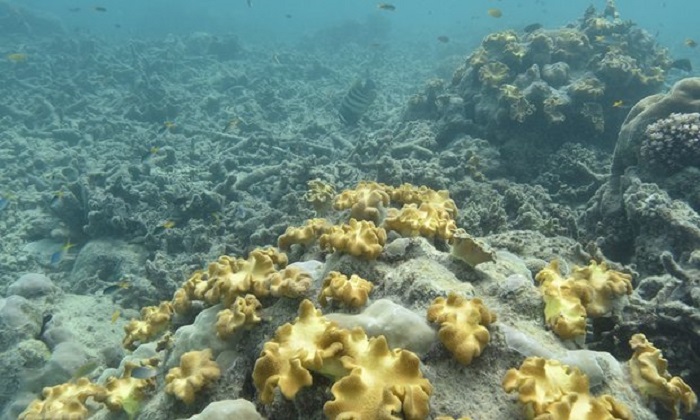Marshall spent a week this month conducting surveys on the reefs around Lizard Island.
Marshall said many of the fish species that were commonly seen around branching coral had completely disappeared from the area, including the black-and-white striped humbug damselfish. He said in his time there he saw only one school of green chromis, which were previously seen all over the area.
Marshall said the lack of fish was an indication that there was “complete ecosystem collapse”. Without enough surviving corals, the fish didn’t have the shelter and food sources they needed and had died or moved elsewhere.
Without many of those fish, Marshall said the coral would face a harder time recovering, since the entire ecosystem had been degraded.
He said he was also surprised to see that some of the surviving corals continued to bleach, despite the southern hemisphere winter bringing cooler waters to the Great Barrier Reef.
“There are still corals bleaching,” Marshall said. “Especially noticeable on Lizard Island were the soft corals. Some of them have remained bleached. And some of the hard corals are still white.”
He said many of them were probably not bleaching for the first time now but rather have remained bleached since it began. “They’re just holding on by the fingernails,” he said.
Marshall said he also saw some corals that had recovered, as well as some anemones that had bleached but not died.
But, overall, Marshall estimate that more than 90% of the branching corals had died around Lizard Island. He said many of the huge porites corals, which could be a thousand years old, had died.
Coral and other organisms like anemones and giant clams bleach when water temperatures are too high for too long. When they become stressed, they expel their colourful symbiotic algae that provide them with energy, becoming pale or white. Unless the water temperatures quickly return to normal, many of those organisms die.
Lizard Island was particularly badly hit by the global bleaching event that hit every major reef region in the world and killed almost a quarter of the coral on the Great Barrier Reef. But, in the northern section of the Great Barrier Reef, between Lizard Island and the Torres Strait, a majority of the coral is thought to have died.
The mass bleaching this year was driven by climate change, which raised water temperatures close to the maximum threshold coral could stand, and a strong El Niño that bumped the temperatures above that threshold.
More about:
















































